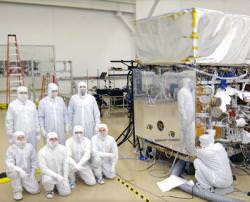NASA has Hubble, Spitzer and Chandra to cover visible, ultraviolet, infrared and X-ray portions of the electromagnetic spectrum. The next wavelength to get its own space telescope is gamma rays. When NASA’s Gamma ray Large Area Telescope (GLAST) launches in December, there will be a powerful new observatory in space, capturing more gamma rays than any space observatory to date.
GLAST is currently living in a “clean room” at General Dynamics in Arizon. This is a special enclosed environment with very low levels of contaminants or environmental pollutants. It will remain in this clean room until it’s transfered to the launch pad later this year.
When GLAST finally makes it into orbit, it’ll be the most powerful and sensitive gamma ray observatory ever launched, gathering photons that can contain hundreds of billions of times more energy than we perceive with our eyes. These gamma rays are generated in the most extreme events in the Universe, such as the disks of gas swirling around black holes.
Unlike the other space-based observatories, GLAST doesn’t have a mirror to focus the photons; gamma rays don’t work that way. Instead, it’s got a large detector capable of detecting any gamma rays in 20% of the sky. It’ll orbit the Earth every 95 minutes, and image most of the sky 16 times a day. It can also be directed to stare in a specific direction to image an event, such as the afterglow from a gamma ray burst.
Original Source: NASA News Release

